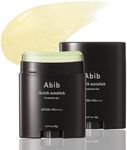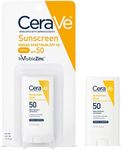Buying Guide for the Best Sunscreen Sticks
Choosing the right sunscreen stick is essential for protecting your skin from harmful UV rays. Sunscreen sticks are convenient and easy to apply, making them a great option for on-the-go sun protection. When selecting a sunscreen stick, it's important to consider several key specifications to ensure you get the best product for your needs. Here are some important factors to keep in mind when choosing a sunscreen stick.SPF (Sun Protection Factor)SPF measures the level of protection a sunscreen provides against UVB rays, which are the main cause of sunburn. The higher the SPF number, the greater the protection. SPF values typically range from 15 to 100. For everyday use, an SPF of 30 is generally sufficient, but if you are spending extended time outdoors, especially in direct sunlight, you might want to opt for SPF 50 or higher. Consider your skin type and the intensity of sun exposure when choosing the SPF level.
Broad Spectrum ProtectionBroad spectrum protection means the sunscreen protects against both UVA and UVB rays. UVA rays can prematurely age your skin, while UVB rays can burn it. It's important to choose a sunscreen stick that offers broad spectrum protection to ensure comprehensive coverage. Look for labels that specifically mention 'broad spectrum' to ensure you are getting protection from both types of rays.
Water ResistanceWater resistance indicates how long the sunscreen remains effective while you are swimming or sweating. Sunscreen sticks can be water-resistant for either 40 or 80 minutes. If you plan to be active outdoors, especially in water or while sweating, choose a sunscreen stick with higher water resistance. Reapply as needed, especially after towel drying or excessive sweating.
IngredientsThe ingredients in sunscreen sticks can vary, and it's important to choose one that suits your skin type and preferences. Look for active ingredients like zinc oxide or titanium dioxide for mineral sunscreens, which are often gentler on sensitive skin. Chemical sunscreens may contain ingredients like avobenzone or octinoxate. Additionally, consider if you prefer a fragrance-free option or if you have any allergies to specific ingredients. Reading the label can help you make an informed choice.
Application and TextureThe ease of application and texture of the sunscreen stick can affect your overall experience. Some sticks glide on smoothly and leave a non-greasy finish, while others might feel sticky or heavy. Consider how the sunscreen feels on your skin and how easily it can be applied. If you have oily skin, you might prefer a matte finish, whereas dry skin might benefit from a more moisturizing formula. Test a small amount if possible to see how it feels on your skin.
Size and PortabilitySunscreen sticks come in various sizes, and portability can be a key factor, especially if you need to carry it with you throughout the day. Smaller sticks are convenient for travel and can easily fit in a pocket or bag, while larger sticks might offer more product but be less portable. Consider your lifestyle and how often you need to reapply sunscreen when choosing the size of the stick.
















